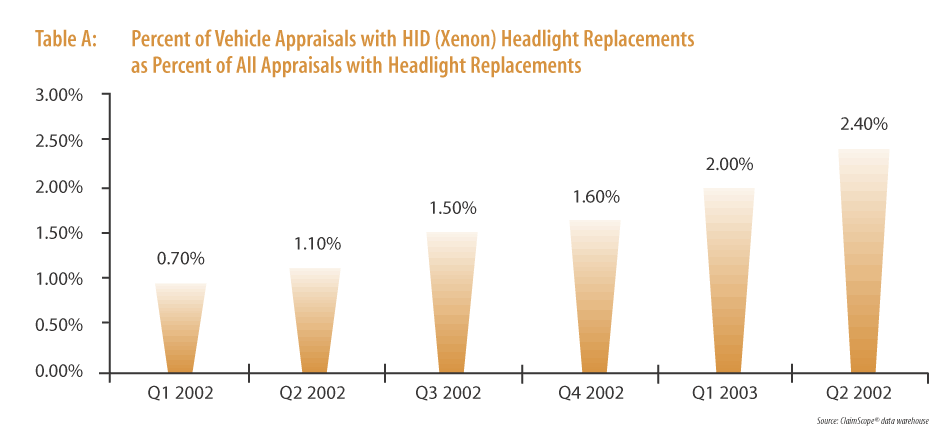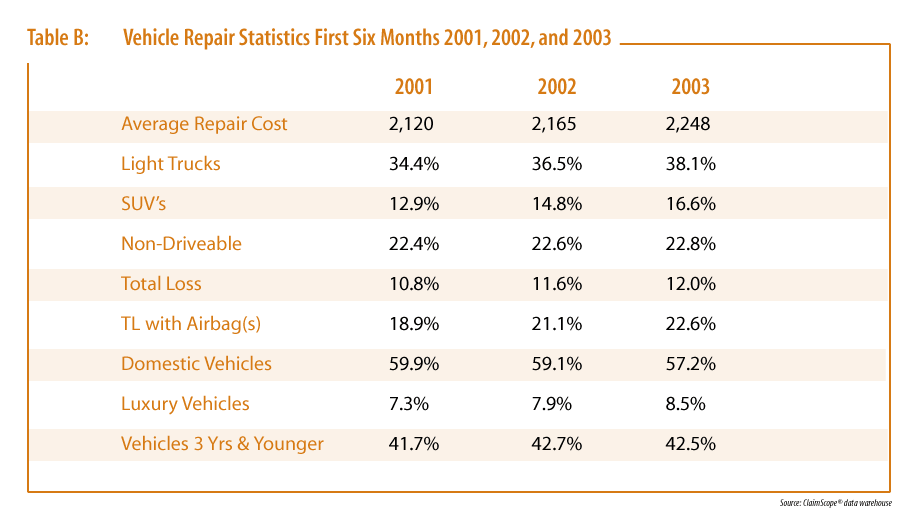
| industry insights | |
| introduction | |
| features | |
| departments/columns | |
| Industry Trends | |
| Perspective | |
| Technology | |
| Perspective | |
| CCC News Wire | |
| who we are | |
| archives | |
| CCC UpFront home |
| industry trends |
| Consumer Impact on Collision Repair Industry |
| By Susanna Gotsch |
|
Whether consumers are reporting fewer claims, opting to drive damaged vehicles, or simply having fewer accidents, nobody seems to know. What is known is that claim volume continued to decline in the first half of 2003, prolonging a trend that dates back to 2001. Fast Tracki, published quarterly by the National Association of Independent Insurers and Insurance Services Office, Inc. to monitor claims frequency and losses to premiums, reported claims frequencies declined by nearly two percent in the first quarter of 2003 from the same quarter the previous year. This, after finding claims volume shrank 3.5 percent year-over-year from 2001 to 2002. Reduced claim frequency has had a negative impact on most in the collision repair industry. A CollisionWeekii survey of business conditions and repairer optimism found the majority of repair facilities experienced declining sales and profits for the first quarter of 2003 compared with the first quarter of 2002. In fact, 51 percent of repairers reported decreased sales. Of those that did not report a loss in Q1 of 2003, 22.7 percent saw sales stay flat and only one-fourth of collision repairers (26.4 percent) reported an increase in sales. Higher Repair CostsDespite lower claims volumes, vehicles that are being repaired are costing more, in large part due to consumer vehicle choice. The average loss per claim as reported by Fast Trackiii was up 5.8% in the first quarter 2003, and CCC's ClaimScopeŽ data reveals an increase of 2.3% in average repair costs at mid-year this year than the same time period in 2002. At mid-year 2003, the average repair cost was $2,248 - 2.7 percent higher than the 2002 average of $2,190. This trend can be attributed to multiple factors, including: the increase in average labor-hours per repair; greater number of replaced parts per repair; and continued shifts toward vehicles that are more costly to repair. Parts are playing a role in the increase of vehicle repair costs. On average, 7.9 parts were replaced per vehicle repair at mid-year 2003, compared to 7.8 in 2002. Alternative parts usage (non-OEM parts as a percent of the total dollars spent on parts) has grown to 25.8 percent, but remains below its peak at 28.1 percent in 1998. As manufacturers increase the use of materials like high strength steel and aluminum, and integrate vehicles with features such as HID or Xenon headlights, side and head airbags, and collision avoidance systems, parts replacements are expected to increase further. And in some cases to cost more. For example, Xenon or HID lighting is helping to increase the cost of repair. Over 140 vehicle makes have included HID as optional or standard options since model year 2000 - 35 model year 2003 vehicles include them as standard options. These headlights are more costly than non-Xenon types, sometimes costing as much as eight times more per headlight ($100 per non-Xenon headlight compared to $800 per Xenon headlight). Analysis of vehicle appraisals that included one or more headlight replacements from first quarter 2000 to second quarter 2003 reveal an increase of over 200 percent (from 0.7 percent to 2.4 percent) of those that were the higher cost Xenon headlights. See Table A.
The percent of vehicles deemed non-repairable, or total loss continues to increase-total loss volumes have been reported as high as 18-20 percent of all vehicle claims (note the 12 percent in Table B above is for appraisals flagged as non-repairable, and does not incorporate those vehicles that were obvious totals for which an appraisal was not generated). Accidents Waiting to Happen A national poll of driver attitudes and behaviors commissioned by Coalition of Highway Safety Experts' "Drive for Life" program and completed by the Mason-Dixon Polling and Research Inc. identified the following trends:
In addition, a study commissioned by Direct Line Insurance would suggest that driver performance is more impaired by talking on a cellular phone that most any other activity, including driving while intoxicatedv. Drivers' reaction times were 30 percent slower on average when talking on a hand-held mobile phone compared to being drunk, and nearly 50 percent slower than under normal driving conditions. Consumer behavior has always played a role in the collision repair industry. However, because the decisions consumers make today are having a greater effect on repairers livelihoods, it has become more important for all of us to understand and anticipate consumer preference and action. Susanna Gotsch is director of analysis and reporting at CCC Information Services Inc., and author of Crash Course. i "Countrywide Fast Track Monitoring System Private Passenger Automobile Claim Cost and Claim Frequency Data". Fast Track as of 1st Quarter 2003. National Association of Independent Insurers; Insurance Services Office, Inc.; National Independent Statistical Service., April 2003. ii"Business Conditions and Repairer Optimism: Report for first quarter 2003." CollisionWeek, Monday, May 12, 2003. iii"Countrywide Fast Track Monitoring System Private Passenger Automobile Claim Cost and Claim Frequency Data". Fast Track as of 1st Quarter 2003. National Association of Independent Insurers; Insurance Services Office, Inc.; National Independent Statistical Service., April 2003. iv"Surveyed Drivers Admit to Frequent, Dangerous Driving Habits," CollisionWeek, Friday, May 31, 2003. v"Talking on a Mobile Phone Whilst Driving is MORE Dangerous Than Being Drunk Behind the Wheel", 22nd March, 2002. www.info.directline.com. |
 The collision repair industry is becoming more reliant on the consumer-and the choices she makes. While, to some extent, this has always been the case, it has never been as apparent as it is now. As 2003 nears its end, let's look back at some of the most important trends of this year, and catch a glimpse of the consumer. Her choice of vehicle, conduct behind the wheel, and accident report rate are having a major effect on the industry.
The collision repair industry is becoming more reliant on the consumer-and the choices she makes. While, to some extent, this has always been the case, it has never been as apparent as it is now. As 2003 nears its end, let's look back at some of the most important trends of this year, and catch a glimpse of the consumer. Her choice of vehicle, conduct behind the wheel, and accident report rate are having a major effect on the industry.
